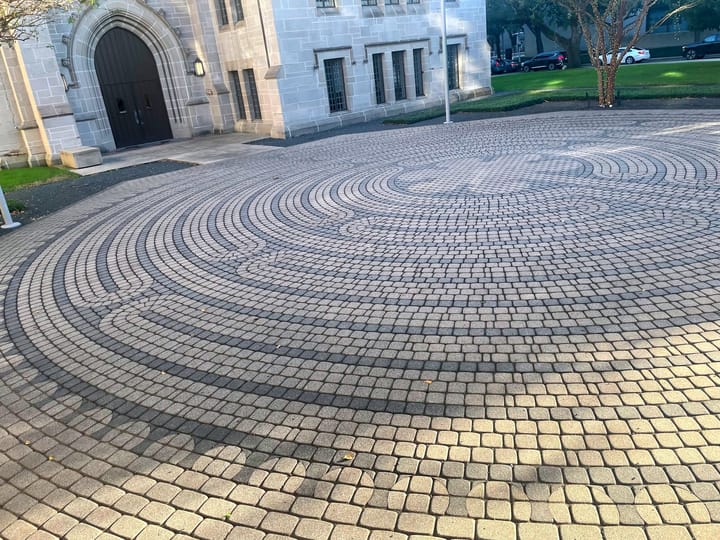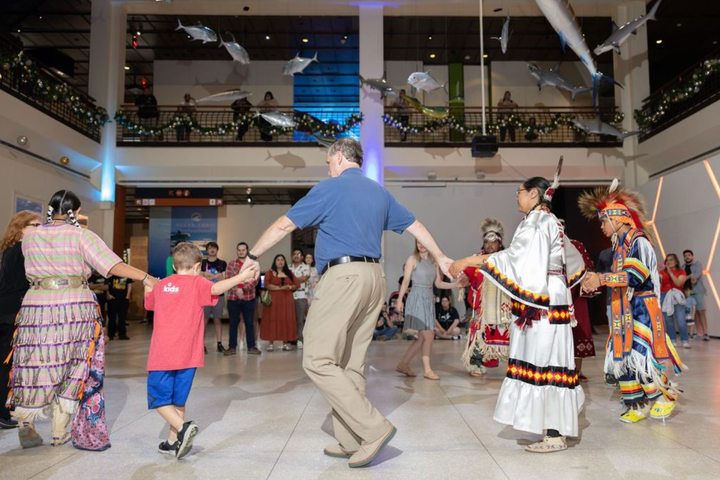What Happened To The 10,000 Afghan Refugees Who Resettled In Texas?

Late one evening in February 2022, Chinar Sediqi touched down at San Antonio International Airport for the first time. He was with his wife, Noorafshan, and their five children, the youngest only one year old. The older children gathered their backpacks and the family retrieved three boxes filled with belongings at baggage claim. In the past six months they had made a terrifying escape from their home in Afghanistan’s Paktika Province. They had driven five hours to Kabul, made it past crowds at the airport, boarded onto a U.S. military evacuation flight, slept on a crowded floor in a military base, and lived in a small hotel room in Baltimore.
Sediqi had requested that his family be resettled in Texas as he had a cousin who lived there, but they were sent to Baltimore instead. After three months, a case worker was finally able to raise funds for their trip to San Antonio.
When Sediqi exited the terminal, he saw his cousin as well as two nephews who had evacuated Afghanistan with him but were later separated. Sediqi hadn’t known if he would see any of them again. As he stepped out into the tepid San Antonio air, Sediqi felt emotional. The weather reminded him of home. When they arrived at his cousin’s apartment, a feast of traditional Afghani food lay before them. It had only been a few months since he and his family had left everything behind, but it felt more like a decade. He didn’t realize how much he’d missed familiar food until it was in front of him. The family sat on pillows and ate together. They laughed and talked well into the night. It was the best evening he’d had in a long time. The next day, they planned to begin the process of restarting their lives in America.
--
When the U.S. military withdrew from Afghanistan in August 2021, approximately 76,000 at-risk Afghans were evacuated and brought to safety in the United States. The last time the U.S. had resettled this number of refugees was after the Vietnam war, when 130,000 Vietnamese were brought to America. Texas received more Afghans than any other state – with approximately 10,500 being resettled here. Nearly half, or 5,117, went to Houston, 2,294 went to Dallas-Fort Worth, 1,763 went to San Antonio, and 901 went to Austin. The state’s resettlement organizations weren’t prepared for this sudden influx. The agencies had lost staff and funding during the Trump administration and the COVID-19 pandemic, when refugee numbers fell drastically. Evacuees faced major shortages in housing, support, and mental health resources after they arrived.
In addition, many of the new arrivals struggled to communicate in English or had no paperwork to qualify them for benefits or work permits – a major change from previous Afghan refugees, who typically arrived with Special Immigrant Visas and were familiar with U.S.-culture from time with the American military. The recent arrivals had also suffered unimaginable trauma during the evacuation, or were separated from their families, something most agencies hadn’t dealt with before.
For many evacuees, their immigration status remains in limbo to this day. Upon arrival, they were given a two-year status called Humanitarian Parole. Late last year, the Biden Administration granted them Temporary Protected Status, which allows them to continue working and living in the country, but it does not provide a path to citizenship and can be revoked at any time, potentially forcing them to return to Afghanistan. This status could be particularly vulnerable if Trump were to take office next year. Living with such uncertainty has made it especially difficult for evacuees to rebuild their lives.
As Afghan evacuees enter their fourth year in the U.S., what happened to those like Sediqi and his family? Have they managed to build a new life in Texas? Or were the myriad of challenges they faced in the state too much to overcome?
--
In Afghanistan, Sediqi had been a surgeon, directing a hospital and working with the U.S. Army. He never intended to leave his home in the Paktika Province region. But when the Taliban came to his province, he heard they were capturing medical personnel who had worked with U.S. troops. He and his family slept in the hospital in case the Taliban tried to come to his home. Then his worst fear came true. His neighbor alerted him that the Taliban had entered his house in the middle of the night searching for him and asked neighbors about him. He made arrangements the next day to drive to Kabul, a dangerous and harrowing journey, in hopes that he and his family could make it onto an evacuation flight.
His cousin worked on an Afghan police force and was able to get Sediqi and his family through the crushing crowds and into the airport. When Sediqi learned they would be headed to the U.S., he hoped he could use his surgical skills there. But when he arrived at the Fort Bliss army base in New Mexico, he learned how challenging that might be, as there are significant barriers for internationally-trained physicians to obtain licensing in the U.S. Many physicians must start over in low-paid positions or gain entrance into competitive residency programs to practice. So when he arrived in San Antonio, his primary goal was simply to earn enough to feed his family and rent an apartment. His cousin had a four-bedroom apartment, but it wasn’t big enough to fit all seven of them. Sediqi went to Catholic Charities for help finding a place to live.
For Texas resettlement agencies, finding enough available housing for nearly 11,000 evacuees was a difficult task. Ahmed Mushref, the former deputy director of refugee services at Interfaith Ministries for Greater Houston, helped resettle more than 1,000 Afghan evacuees in Texas. In the past, the average family size of new arrivals was four to six, and resettlement agencies would set up an apartment before the family even arrived, he explained. Now, larger families of 10 or more people were arriving. Finding available apartments for these large families was especially challenging.
Additionally, the volume was overwhelming. Before August 2021, Mushref had previously dealt with about five resettlement cases a month, with refugees coming from places like the Congo, Syria, Guatemala, and occasionally Afghanistan. But that summer, Afghan evacuees began arriving at the airport in rapid succession, with an average of 10 to 12 families every day.
He began booking rooms at a La Quinta in West Houston, which could accommodate 100 people, with the goal of transferring families to apartments within two weeks. To secure apartments, Mushref and his team walked door to door at apartment complexes, asking to speak to landlords and explaining the situation. Many landlords were hesitant and didn’t understand the process of resettling refugees. Mushref explained that Interfaith Ministries would cover rent, at least initially. Once rented, Mushref’s team then needed to furnish the apartments. The families weren’t eligible for food stamps or Medicaid yet (typically refugees can immediately access these types of services), so Interfaith Ministries set up a monthly food allowance through a combination of a refugee cash assistance program, federal grants, and local donations, and worked with clinics to provide medical care. They also supported families in other ways, like creating a play area in the hotel’s storage room with a trampoline and a small slide. Mushref and other staff were regularly putting in 16- to 18-hour days.
Families were thrilled to be transferred to apartments, but Mushref noticed that weeks or months later, after their immediate needs were met, it was common for mental health issues to surface. Interfaith Ministries has an intensive case management program to address these challenges and connect clients with mental health professionals. Mushref estimates approximately 20 percent of his clients have accessed these services, yet “the need is much bigger than what we have,” he says. “Leaving their country was a traumatizing experience and it weighed heavily on them.”
One of the toughest issues for evacuees and resettlement agencies was dealing with family separations. Sediqi had to leave behind his brother and sister, but many others had to leave behind nuclear family members – including spouses and children. Mushref met a father and his daughters who were able to pass through the checkpoint, but the wife and sons were left behind in Afghanistan. He also had children arrive without their parents. In one case, the parents had handed their young children to a cousin at the Kabul airport, but then the line stopped before they could pass through. He and his team launched a program focused on family reunification, reaching out to state and federal government officials for help, but made little progress. “Every day, we heard heartbreaking stories of what people went through,” says Mushref.
Margaret Costantino, the executive director for the Center of Refugee Services, a nonprofit providing social, employment, and legal services to refugees in San Antonio, dealt with similar frustrations. “Chaos was the primary descriptor of the whole experience,” she says. Costantino worked closely with resettlement agencies like Catholic Charities to provide thousands of Afghan evacuees with basic hygiene supplies, English instruction, health referrals, and to help new arrivals settle into their new homes. Costantino and her team also attempted to help reunite families to no avail. For months, 30 to 50 people a day lined up outside the center’s office, begging her staff to submit the names of their relatives for evacuation. “We were inundated with requests for reunification, and we had stacks and stacks of forms that we filled out and forwarded to our congressional representatives hoping that it would lead to some kind of relief,” she says. “But we soon realized that a mechanism for additional evacuations did not exist.”
--
At Catholic Charities, a caseworker helped Sediqi submit an application for Medicaid and food stamps. She enrolled him in a rental assistance program, and provided him with temporary cash assistance. He connected with a lawyer to apply for asylum. Over the next few weeks, Catholic Charities helped him find a two-bedroom apartment with a yard for $900 a month in North San Antonio. The Center for Refugee Services furnished it with beds, chairs, a table, and kitchen supplies.
Many evacuees showed up without papers or passports, and unlike traditional refugees who are given green cards and able to work immediately, their Humanitarian Parole status did not include a work permit. Interfaith Ministries waited for instructions from the federal government on what to do. The organization’s goal is to have new arrivals hired within 90 days, but without work permits, there was little staff members could do to help. For many Afghans arriving in the fall of 2021, it took six months to a year for work permits to finally come through.
Sediqi was one of the lucky few who received his work permit within the first two months. He then used the cash assistance he had received to purchase a 2013 Toyota Avalon and signed up to drive for DoorDash. In the spring of 2022, he was hired as a home caregiver at Stone Oak Home Health Services. He worked with two different patients, each for about three hours a day. He was commuting about 90 minutes each way, and continuing to fit in DoorDash shifts before or after work. Nearly 10 months after arriving in San Antonio, he was earning enough to take over the rent payments for their apartment.
In late 2022, he was hired as a community health worker at UT Health San Antonio Refugee Health Clinic to support Afghan refugees. He began taking five- to six-hour shifts there, working as an interpreter for Worldwide Language Program, and driving for Lyft and Uber when time allowed. Recently, Sediqi received a surgical first assistant certificate, and hopes to find work at a surgical center.
“Once evacuees have a job, they feel more confident and start identifying other skills and needs in the employment market,” says Mushref. Interfaith Ministries organized job fairs to connect evacuees to the employers who needed them. For Afghans who were fluent in English, Mushref helped place many of them in transportation jobs. For those with limited English, Mushref’s team worked with employers like Hilton Hotel and Daikin Industries, a Japanese AC manufacturing company, to place clients. Today, more than 90 percent of Mushref’s clients are employed and self-sufficient.
Bibihawa Naseri arrived in Houston in September 2021 with her husband and nine children, ranging in ages one to 18. Naseri didn’t speak English and couldn’t read the ingredients on packages at the grocery store or understand the doctor at her first visit. Mushref’s team connected her with a caseworker who spoke Pashto, and Naseri’s husband was soon hired on the assembly line at Daikin, while she stayed home to care for their children. Interfaith Ministries placed them in a three-bedroom apartment, and after a year, her husband had earned enough for them to move out on their own. They began renting a four-bedroom house in West Houston. Recently, Naseri found part-time work as a home caregiver for an elderly woman who also speaks Pashto, earning about $150 to $200 a week.
--
In the spring of 2024, Sediqi and his wife were approved for asylum, which gives them five-year work authorization cards and a path to permanent residency. Sediqi’s older children are thriving in school and amaze him with their English fluency. His eldest son graduated high school and is working at KFC. His middle son graduated with honors and entered college this fall to study cybersecurity, and his eldest daughter is in seventh grade and wants to study medicine.
Sediqi hopes he can bring over his brother and sister one day, in addition to his nephew who fled to Pakistan after escaping imprisonment by the Taliban and is waiting for a visa. But he knows many Afghan families have been waiting years for reunification. After two and a half years, Mushref recently succeeded in reuniting families who were torn apart during the evacuation. This past spring, the parents who were separated from their two-year-old after handing the child to a cousin at the Kabul airport, finally landed in Houston to reunite with their son. The reunification was emotionally fraught, as the child wasn’t able to recognize them. “It has taken them some time to really connect again,” says Mushref. Another teenager who came to the U.S. alone and living with a guardian in Florida was finally able to reunite with his family. Costantino at the Center of Refugee Service in San Antonio has heard of a few success stories from separated family members escaping Afghanistan and traveling up to the U.S.-Mexico border through Brazil. But there are still hundreds more waiting and hoping for reunification.
On a recent Saturday, Chinar Sediqi spent the afternoon strolling along the San Antonio River Walk with his family. “Back in Afghanistan, we were always worried about someone trying to kill us or kidnap our children,” he says. “Living here is the first time we felt freedom.”



Comments ()